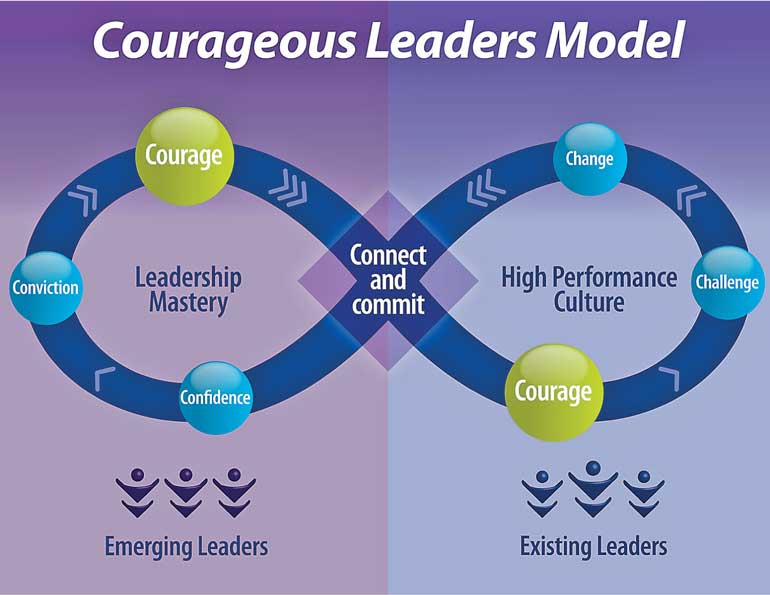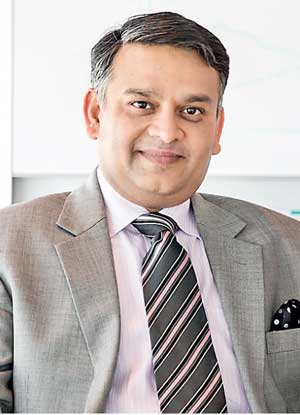Monday Mar 17, 2025
Monday Mar 17, 2025
Wednesday, 3 August 2016 00:00 - - {{hitsCtrl.values.hits}}

Courageous Leadership Model by courageousleaders.au
 By Prof. Todd Henshaw
By Prof. Todd Henshaw
I was teaching leadership at a French telecom company several years ago, and the CEO visited on the last day of the program to take presentations from participants focused on a question he had provided them earlier in the week. The question was, “How can we become more courageous as a company?”
I had coached the participants during the week, helping them think through what it means to be personally courageous as leaders, and how this company, which had not been performing and was still recovering from the economic crisis, could make a comeback.
The discussion quickly turned to the question of why people had become less courageous in the recent past, and how we could promote courageous behaviour across the organisation. The CEO had posed these questions in many prior programs, but this time, he had struck a chord with participants.
The question prompted a discussion of leadership in the organisation, and the culture that had been shaped by the economic crisis and difficult, yet necessary corporate reactions like downsizing, budget-cutting, and less tolerance for even honest mistakes.
Participants reflected how the organisation had become reactive rather than proactive, and managers had begun to micromanage and had difficulty making timely decisions without consulting senior leadership. Senior leaders stopped talking about the future, where the company was headed, and most important, they had stopped challenging the people in the company to innovate, take the initiative, or focus on the customer.
The experience with executives in France prompted me to develop a program called ‘Courageous Leadership’ that I now teach at Wharton, and to many consulting clients that are feeling the inertia associated with the loss of courage in their leaders, and at many levels in the organisation. So what causes this loss of courage, and how can we enable courageous leadership and culture?
Personal courage is related in the psychology literature to self-esteem, empathy, and confidence, and we can even think of stories that depict acts of heroism and bravado, “larger than life” figures who save the passengers of the ship, or run into a burning building to rescue an elderly resident.
In organisations, courage takes on a different form, and can be better associated with how people deal with increasing uncertainty and complexity in their work. It is in fact during these periods of great uncertainty and volatility that we need greater courage, and better leadership.
Courage is contagious in organisations, and we know that courageous behaviour, especially from a respected and admired leader, generates and promotes greater courage amongst followers across the firm. One clear way to increase courageous behaviour in an organisation is to ensure that leaders are taking smart risks, making bold decisions without complete information, and making hard calls about people and resources.
Yet we still haven’t answered the most difficult question, which is important to all business leaders today; “how can we become more courageous as a company?” When I initially asked this question in the French program, executives looked at each other to see who would go first. The silence in the room was uncomfortable and evidence enough that even in this small sample of company leaders, trust was not part of the culture. They couldn’t even start the conversation.
Without trust, courageous action is rare, especially down the organisation. People need to have trust in leadership to make sense of market and firm uncertainty, trust in the strategic direction of the firm, trust in the team that we’ve put together, and trust that the company will demonstrate the same loyalty and commitment to its people that they have provided it over the years.
Trust is the foundation for courage, and without it, organisations founder. Leaders build trust in organisations by following through on commitments, and by providing a clear understanding of the firm’s purpose and direction. They demonstrate trust in managers and employees by empowering and developing them for more responsibility, and they provide transparency in decision-making, especially people decisions involving compensation, promotions, hiring and firing.
The best leaders I’ve known had the capacity to build confidence in others, in teams, and across organisations. They were “comfortable in their own skin,” courageous enough to be vulnerable, approachable and open in leader-follower relationships, and bold in their empowerment and encouragement of others while ensuring accountability for performance.
Courageous leadership is therefore a type of leadership that builds this necessary trust, and allows organisations to reach their full potential through the dedicated efforts of every manager and employee, while promoting innovation, change, experimentation and learning. It creates an environment where people can take smart risks, share new ideas, and make tough decisions about who is on the team, and who needs to go.
My French client is still experiencing the uncertainty associated with the difficult European economy, but the work that was done to clarify the connection between trust and courage was a catalyst for leadership development and cultural change, led to a change in focus for subsequent leadership programs and even a new definition of leadership in the company.
(The writer is Director of Executive Leadership Programs, The Wharton School and President, Leader Development Associates.)
Professor Todd Henshaw will conduct a two-day leadership workshop with PwC’s Academy on 26-27 August in Colombo. The programme is aimed for C-Suite leaders and will cover Building and Leading High Performance Teams in VUCA world. For more info [email protected] | 0117719874.
Discover Kapruka, the leading online shopping platform in Sri Lanka, where you can conveniently send Gifts and Flowers to your loved ones for any event including Valentine ’s Day. Explore a wide range of popular Shopping Categories on Kapruka, including Toys, Groceries, Electronics, Birthday Cakes, Fruits, Chocolates, Flower Bouquets, Clothing, Watches, Lingerie, Gift Sets and Jewellery. Also if you’re interested in selling with Kapruka, Partner Central by Kapruka is the best solution to start with. Moreover, through Kapruka Global Shop, you can also enjoy the convenience of purchasing products from renowned platforms like Amazon and eBay and have them delivered to Sri Lanka.
Discover Kapruka, the leading online shopping platform in Sri Lanka, where you can conveniently send Gifts and Flowers to your loved ones for any event including Valentine ’s Day. Explore a wide range of popular Shopping Categories on Kapruka, including Toys, Groceries, Electronics, Birthday Cakes, Fruits, Chocolates, Flower Bouquets, Clothing, Watches, Lingerie, Gift Sets and Jewellery. Also if you’re interested in selling with Kapruka, Partner Central by Kapruka is the best solution to start with. Moreover, through Kapruka Global Shop, you can also enjoy the convenience of purchasing products from renowned platforms like Amazon and eBay and have them delivered to Sri Lanka.